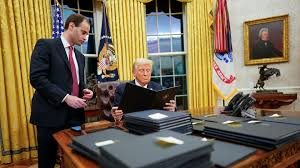On August 9, 2025, President Donald Trump is poised to sign a groundbreaking executive order that could reshape the landscape of retirement investing in the United States. This order will ease restrictions on 401(k) retirement accounts, allowing plan sponsors to include alternative assets like private equity, real estate, and cryptocurrencies in these accounts, which collectively hold an estimated $12.5 trillion in assets. Coupled with guidance from the Department of Labor (DOL) clarifying fiduciary responsibilities, this move aims to diversify retirement portfolios and give Americans more control over their financial future. But what does this mean for investors, employers, and the broader financial ecosystem? Let’s explore the details, implications, and potential pitfalls of this bold policy shift.
A New Era for Retirement Investing
The 401(k) system, a cornerstone of American retirement planning, has long been limited to traditional assets like stocks, bonds, and mutual funds. These restrictions, rooted in the Employee Retirement Income Security Act (ERISA) of 1974, were designed to protect workers from risky investments. However, critics argue they’ve constrained portfolio growth, especially in a low-yield environment. Trump’s executive order seeks to change that by loosening these rules, enabling 401(k) plans to include alternative assets. This shift could unlock access to high-growth opportunities like private equity, real estate investment trusts (REITs), and cryptocurrencies—assets previously reserved for wealthy or institutional investors.
The DOL’s role is critical here. By issuing new guidance, it will clarify how fiduciaries—those managing 401(k) plans—can incorporate these assets while meeting their legal duty to act in participants’ best interests. This could reduce liability fears for plan sponsors, encouraging broader adoption. With 401(k) plans holding $12.5 trillion across 60 million participants, even a small shift toward alternatives could move billions into new markets.
Why This Shift Is a Game-Changer
Opening 401(k)s to alternative assets is a seismic shift for several reasons:
- Diversification: Traditional 401(k) portfolios are heavily tied to public markets, which can be volatile. Private equity and real estate offer exposure to different economic cycles, potentially reducing risk.
- Higher Returns: Alternative assets have historically outperformed stocks in certain periods. For example, private equity has delivered annualized returns of 10–15% over the past decade, compared to the S&P 500’s ~7–10%.
- Crypto’s Mainstream Moment: Including cryptocurrencies like Bitcoin and Ethereum in 401(k)s could legitimize digital assets, driving adoption. Bitcoin’s price, hovering around $60,000 in 2025, has already drawn institutional interest.
This move aligns with Trump’s pro-business, deregulatory agenda, aiming to empower individuals to take risks for potentially higher rewards. It also reflects growing demand from younger investors, with 60% of Millennials expressing interest in crypto for retirement, according to a 2024 survey by Charles Schwab.
The Mechanics: How It’ll Work
The executive order doesn’t rewrite ERISA but directs the DOL to reinterpret its guidelines, making it easier for plan sponsors to include alternatives without fear of breaching fiduciary duty. Key changes include:
- Expanded Asset Classes: Plan sponsors can offer private equity funds, REITs, or crypto ETFs, provided they meet due diligence standards.
- Fiduciary Clarity: The DOL will outline how fiduciaries can evaluate alternative assets’ risks and returns, ensuring compliance with ERISA’s “prudent person” rule.
- Participant Choice: Employees will likely have opt-in options to allocate a portion of their 401(k) to alternatives, capped at 10–20% to limit risk exposure.
For example, a 401(k) participant might allocate 15% of their portfolio to a private equity fund or a Bitcoin ETF, with the rest in traditional assets. Employers like Fidelity, which already offers Bitcoin in some 401(k) plans, could expand these offerings rapidly.
Opportunities and Risks: A Balancing ActThis policy opens exciting doors but comes with challenges. Here’s a breakdown:
- Opportunities:
- Private Equity: Offers access to high-growth startups or buyouts, historically yielding 12–15% returns, per Cambridge Associates.
- Real Estate: REITs provide steady income and inflation hedges, with average returns of 8–10% annually.
- Cryptocurrencies: Bitcoin’s 100%+ annualized returns over the past decade (despite volatility) could supercharge portfolios if timed right.
- Empowerment: Investors gain access to assets once reserved for the ultra-wealthy, democratizing wealth-building.
- Risks:
- Volatility: Crypto’s wild swings—Bitcoin dropped 20% in a single week in 2024—could devastate unprepared investors.
- Illiquidity: Private equity and real estate often have lock-up periods, limiting access to funds until retirement.
- Complexity: Alternative assets require financial literacy, and many 401(k) participants may lack the knowledge to navigate them.
- Fiduciary Scrutiny: Plan sponsors face increased regulatory oversight, as the DOL has warned about crypto’s speculative nature in prior guidance.
The DOL’s clarified fiduciary rules aim to mitigate these risks by requiring robust due diligence, but the onus will still fall on employers and participants to make informed choices.
The Broader Impact: Markets and Beyond
This executive order could ripple across financial markets. With $12.5 trillion in 401(k) assets, even a 5% shift to alternatives could inject $625 billion into private equity, real estate, and crypto. This could:
- Boost Crypto Adoption: Institutional inflows into Bitcoin and Ethereum ETFs could push prices higher, with analysts predicting Bitcoin could hit $100,000 by 2026 if mainstreamed.
- Fuel Private Markets: Private equity and venture capital funds could see unprecedented inflows, spurring innovation in tech and healthcare.
- Challenge Traditional Finance: Wealth managers may need to adapt as 401(k)s compete with high-net-worth investment options.
However, critics warn of systemic risks. A 2024 DOL report cautioned that crypto’s volatility could destabilize retirement savings, and widespread adoption might amplify market bubbles. Labor unions and consumer advocates have also raised concerns about exposing unsophisticated investors to complex assets, potentially leading to losses.
What’s Around the Corner?
The executive order is just the start. Implementation will unfold over months, with the DOL expected to issue detailed guidelines by Q1 2026. Key developments to watch include:
- Regulatory Pushback: Congress or the SEC could challenge the order, citing investor protection concerns.
- Employer Adoption: Large firms like Fidelity and Vanguard may lead, but smaller employers might hesitate due to compliance costs.
- Market Reaction: Crypto and private equity markets could see short-term surges as 401(k) inflows begin.
Investors should expect a phased rollout, with larger plans offering alternatives first. Education campaigns will be crucial to help participants understand risks and rewards.
A Bold Step Forward?
Trump’s executive order is a watershed moment for retirement investing, breaking down barriers to alternative assets and giving Americans more control over their $12.5 trillion in 401(k) savings. For developers and entrepreneurs in private equity, real estate, and crypto, it’s a chance to tap into a massive new capital pool. But with great opportunity comes great responsibility. The DOL’s fiduciary guidance will be key to balancing innovation with safety, ensuring this shift doesn’t jeopardize retirees’ futures. As the policy takes shape, it could redefine how Americans save, invest, and dream about retirement—whether that’s a beach house or a Bitcoin fortune.
Sources:
- Bloomberg (2025)
- Charles Schwab Investor Survey (2024)
- Cambridge Associates Private Equity Report (2024)
- U.S. Department of Labor ERISA Guidance (2024)
- Fidelity Investments 401(k) Trends (2025)
- CoinDesk Bitcoin Price Analysis (2025)



























